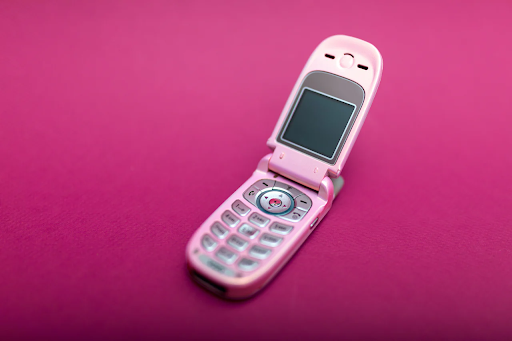Flipping Back to the Flip Phone

September 17, 2021
Through the year 2020, Apple and Samsung have sold approximately 435 million smartphones, enough devices to give every American a phone with extra to spare. These phones, ranging from $700 to $1200 (Visual Capitalist), cost people billions of dollars collectively, promising them the ‘next best thing’. If the ‘next best thing’ for these people was to waste their precious time, then they surely got what they wanted.
Smartphones provide the average user with every app they could ever want. As long as the phone has a connection to the internet or cellular data, users can watch movies, browse Tik Tok, or invest in stocks with the click of a button. Many smartphone users are teenagers and students. In America alone, 96% of college students (ages 18-29) have a smartphone that they use on a daily basis. 75% of students (ages 17 and below) (npr) also have a smartphone of some sort. While these phones may give students some opportunities and tools, they also take away something from students: time.
The saying, “time is money”, is well known by students and adults alike, but during the highschool developmental years it can mean so much more. Time can allow a person to learn new skills while not having to worry about adult-ish things that are coming sooner than a student might think.
Time allows you to explore and enjoy nature. Where we live in Colorado hiking and biking are very popular activities that take up a fair amount of time. If a high school student is spending over seven hours a day on their phone, they aren’t going to have enough time to explore, learn things, or make money for their futures. Without participating in activities, organized or unorganized, students not only waste their time on media but also don’t build character for themselves. Character is built from challenges and experiences, both of which are not found in depth through your smartphone.
The functions of a phone that are necessary in today’s world are actually very simple, but often not thought of as enough. A phone doesn’t need to be able to open up Instagram or Snapchat to be a useful and worthwhile tool, even if you are a student. When phones were first introduced they were used for communication only. Smartphones didn’t exist and phones were confined to spaces like restaurants or houses of prestige. The progression of technology has caused us to forget a phone’s main purpose, communication. We view it now as a toy and symbol of superiority in a sense. People want to show that they have the latest and greatest invention even if it’s a small device like a phone. Having something newer and more expensive makes the user feel better and more confident about themselves even if it’s due to something shallow like a new phone. If we are able to shake the image of what a phone is supposed to be in the modern world, wasting time will be harder and levels of happiness will most likely rise. One of the best ways to do this is to switch back to using a flip phone.
In 1996 the StarTAC, created by Motorola, was the first flip phone released for consumption. This phone did everything necessary to communicate with others. You could call whomever you needed to call and you could text others. Sure, this phone didn’t have the ability to access Youtube or Wikipedia but that’s because it was a tool not a toy. Because flip phones were tools, people used them as such. People didn’t live their lives idly, scrolling through social media or keeping up with their favorite celebrities . With a flip phone only covering the basics of communication, people spent very little time on them. Human interaction was valued much more and the flip phone was a way to schedule that human interaction.
As of 2021, there is only one High School student that I know who uses a flip phone in his day-to-day life. His name is Mason Barnhurst, and he is a senior at FMHS. Barnhurst switched to a flip phone at the start of summer in 2021. “It was a great choice for me. Many afternoons I found myself watching netflix or scrolling through instagram but without those options(on my flip phone), I found better ways to spend my time. With fewer distractions, I can focus on things I love and want to get better at.” Barnhurst is a skateboarder and enjoys skiing with his friends during the winter months.
As smartphones continue to clutch society tighter and tighter, it may seem harder to get free from their grasp, especially as a student. Smartphones provide comfort and ways to feel like you’re doing something when in reality you’re usually just wasting your time. With comfort comes consequences like laziness and lack of creativity. It’s important to remember there are alternatives such as flip phones which cover all basic needs of communication while also saving your precious time and your/your parents money. Ultimately, you can control your phone or your phone can control you, but that decision is for you to make.
